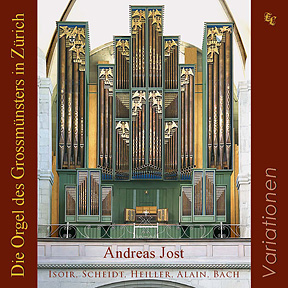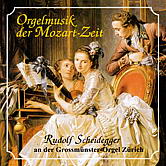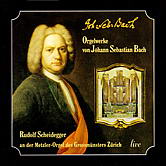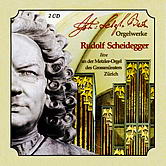Edition Lade - EL CD 054
Die Orgel des Grossmünsters in Zürich - Variationen
Andreas Jost, Orgel
1 CD - DDD - Spielzeit: 67' 29
Booklet: deutsch / französisch / englisch - 36 Seiten - 9 Abbildungen
€ 18,90
V a r i a t i o n e n
Wie die Evolution des Lebens an sich - die immer währende Variation des Individuellen, gewachsen um neue Erkenntnisse - ist es angesichts der ureigenen Aufgabe der Kunst im Allgemeinen und der Musik im Speziellen dieses Er-Lebnis zu verarbeiten und zu beschreiben, das unstillbare Bedürfnis der Künstler, Musik zu variieren, zu mutieren und einer imaginären Vollendung näher zu bringen. In der Musikgeschichte entstanden so die vielfältigsten Formen kreativer Veränderung und entsprechend den gesellschaftlichen Anforderungen und Präferenzen der jeweiligen Zeit unterschiedliche Profile des Genres: Variationen liturgischer Natur wie die Choralvariation, die Choralpartita, oder die Paraphrase über gregorianische Gesänge, die meist auch den textlichen Inhalt berücksichtigen, bzw. Variationen zu weltlichen und nicht programmatischen Themen, die den Hörer unterhalten sollen und in der Hoch-Zeit der reisenden Virtuosen der Romantik überaus beliebt waren. Dabei wurde vor allem zwei Techniken gehuldigt: der ostinaten Form wie der Chaconne oder der Passacaglia, bei denen ein Thema permanent wiederholt wird und sich lediglich der harmonische Kontext - auch figurativ - verändert, sowie der Charaktervariation, bei der ein melodischer Duktus rhythmisch, melodisch, dynamisch und harmonisch variiert wird. Das Programm dieser CD lässt mit klingenden Mitteln etwas von den endlos erscheindenden Möglichkeiten evolutionärer Variationskunst erahnen.
Manfred Meier-Appel
V a r i a t i o n s
L’évolution est au cœur de la vie. Sous l’effet de nouvelles connaissances, le vivant est soumis à une variation permanente. Si la fonction primaire de l’art en général et de la musique en particulier est bien d’exploiter et de décrire ce vécu, on comprendra aisément le besoin irrésistible qu’éprouvent les artistes de varier la musique, de la transformer et de l’amener au plus près d’une perfection imaginaire. C’est ainsi que dans l’histoire de la musique sont apparues, en lien avec les exigences et les préférences de chaque époque, les formes les plus diverses de ce changement créatif. Différents profils se sont affirmés: variations de nature li-turgique comme les variations sur un choral, la partita de choral, la paraphrase de chants grégoriens, qui prennent généralement en compte le contenu textuel, ou encore variations sur des thèmes profanes et non programmatiques, genre visant à divertir l’auditeur et particulièrement prisé à l’époque des virtuoses itinérants du romantisme. Deux techniques étaient alors en faveur : d’une part la forme ostinato comme la chaconne ou la passacaille, dans lesquelles un thème est constamment ré-pété dans un contexte harmonique qui varie, d’autre part les variations de caractère, qui font varier un ductus mélodique en son rythme, sa mélodie, sa dynamique et son harmonie. Le programme de notre CD ouvre des aperçus sur la richesse insondable et les innombrables techniques de l’art de la variation.
V a r i a t i o n s
Just as life itself has evolved - the never ending mutations of the individual, enhanced by new insights - it is the fundamental obligation of art in general and specifically in music to capture and depict this ex-perience [sic], (i.e. extracted from life) and to make this insatiable pursuit come alive for the listener in imaginary execution by varying and transmuting music. Music history is replete with manifold forms of creative conversion, and, corresponding to societal demands and preferences are manifested in different types of genre: variations of liturgical nature such as chorale variations, the choral partita, or the paraphrasing of Gregorian chant. Most of these musical forms incorporate the use of human language or variations on secular rather than religious themes intended to entertain the listener. And these were the forms widely preferred by the traveling virtuosos of the Romantic period in music. Two practices were especially popular. One was the ostinato form such as the chaconne or the passacaglia, continually varying one theme solely by changing the harmonic context tonally and figuratively. The other was the variation in character during which the characteristic melodic style was rhythmically, lyrically, dynamically and harmonically modified. The works on the present CD demonstrate through the medium of sound a sense of what would appear to be the in-finite artistic potential of evolutionary art.
P r o g r a m m
André Isoir (*1935)01 Six variations sur un psaume huguenot, op. 1
Samuel Scheidt (1587-1654)
Variationen über den Choral Vater unser im Himmelreich
02 1. Versus, Coral in Cantu
03 2. Versus, Coral in Tenore
04 3. Versus, Coral in Cantu
05 4. Versus, Bicinium contra puncto duplici adorn.
06 5. Versus, Coral in Tenore
07 6. Versus, Coral in Basso
08 7. Versus, Coral in Basso
09 8. Versus, Coral in Basso colorato
10 9. Versus, Coral in Cantu colorato
Anton Heiller (1923-1979)
11 Passacaglia in c-Moll
Jehan Alain (1911-1940)
Suite pour orgue
12 Introduction et Variations
13 Scherzo
14 Choral
Johann Sebastian Bach (1685-1750)
15 Passacaglia c-Moll, BWV 582
Weitere Einspielungen der Edition Lade an der Metzler-Orgel des Grossmünsters Zürich
Fotos zum anklicken



